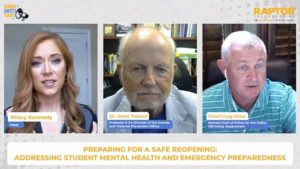Listen to this blog
8 minutes
For years, it has been estimated that the majority of American children have experienced at least one traumatic event. Now, returning to school after the collective trauma of a global pandemic, educators must assume that all of their students have been touched by trauma in some way. In this new school climate, trauma-informed learning will become more important than ever before. Schools can support students healing from childhood trauma by developing trauma-informed classrooms and teaching practices that are sensitive to children’s varying levels of need.
How Common is Childhood Trauma?
The Adverse Childhood Experiences (ACEs) survey was the original measurement instrument used to quantify the scope of childhood trauma in the United States. According to the American Society for the Positive Care of Children, the original ACEs survey measured the following factors:
- Physical, sexual, or verbal abuse
- Physical or emotional neglect
- Separation or divorce
- A family member with mental illness
- A family member with substance abuse
- A family member in prison
- Witnessing a family member be abused
By this measure, the majority of Americans have an ACE score of one, with around 1 in 5 Americans experiencing three or more. However, the effects of childhood trauma may be even further-reaching, given that the ACEs survey only measured a limited number of events.
The prevalence of ACEs and other forms of childhood trauma may be even higher in marginalized communities. For example, studies of racially diverse urban communities have found even higher rates of ACEs than in the general population, especially when accounting for other forms of trauma such as community violence and discrimination.
Experiencing multiple ACEs increases a child’s risk of developing traumatic stress, as well as adverse psychological and physiological health outcomes later in life. These risks can be observed as early as adolescence, with vulnerable early adolescents at higher risk of violence, substance use, and delinquency.
Risk & Protective Factors for Childhood Traumatic Stress
How Trauma Impacts Learning -- and How Schools Can Help
According to the Centers for Disease Control & Prevention, one of the most important things we can do to prevent and address childhood traumatic stress is to connect youth with caring adults and activities outside the home. Educators can play an important role in long-term health outcomes for children who have experienced trauma by serving as caring, trusted adults. Positive school relationships can act as a protective factor, buffering against the long-term health risks of ACEs.
However, for children who have experienced childhood trauma, school may not always feel like a safe place. Sometimes, children may even avoid school because it contains reminders of the traumatic event. The traumatic event may not have occurred in school, but aspects of the school environment — such as particular seating or lighting — can trigger powerful trauma memories for students suffering from traumatic stress.
Educators may be the first to notice signs that a child is experiencing traumatic stress, noting that the student’s school performance and/or attendance declines. By digitally reporting such concerns, teachers can facilitate the identification of at-risk students and connect them with higher-level mental health supports to address traumatic stress.
Examples of Trauma-Informed Teaching Practices
Schools can take additional steps to make the classroom feel like a safe place for all students. A trauma-informed schooling approach assumes that every student has experienced some form of trauma that has the potential to impact their ability to learn. It does not guarantee individualized mental health support to every child; rather, it establishes certain universal teaching practices that benefit all students’ physical and emotional safety.
Trauma-informed teaching practices may include:
- Relationship-building strategies. By greeting students at the door or incorporating their unique individual interests into the curriculum, educators can develop relationships with students that buffer against the negative impacts of traumatic stress.
- Trauma-informed classroom management. Teachers can minimize trauma triggers and maximize emotional safety in the classroom environment by maintaining regular classroom routines and clear expectations for behavior.
- Safe spaces. Classrooms can incorporate “safe spaces” that students can freely use to calm down while feeling dysregulated. These safe spaces may include comfortable seating (e.g. beanbags, exercise balls) and sensory activities (e.g. fidget toys, coloring pages, meditation tapes) to help students cope with trauma triggers.
- Individualized support. In addition to incorporating trauma-informed teaching practices, schools can go a step further by individually identifying students who may be experiencing traumatic stress and connecting them with higher-level supports, such as individual counseling. This can be done by digitally reporting concerns about students’ behavior and mental health.
Many of these trauma-informed teaching strategies will take time and effort to implement schoolwide. One of the simplest ways your school district can become more trauma-informed right now is by facilitating the digital reporting of behavioral concerns, allowing school staff to create a holistic and unified picture of each student’s mental health.
Not only does this practice benefit students suffering from traumatic stress, but it also allows school mental health professionals to streamline their interventions and target those students with the greatest level of need. Better yet, it can be done using existing school safety software, without dramatic changes in policy or demands on school resources.
Related Resources
Podcast
How to Address Student Mental Health & Emergency Preparedness during Reopening.
Learn More
Listen to this blog
8 minutes








